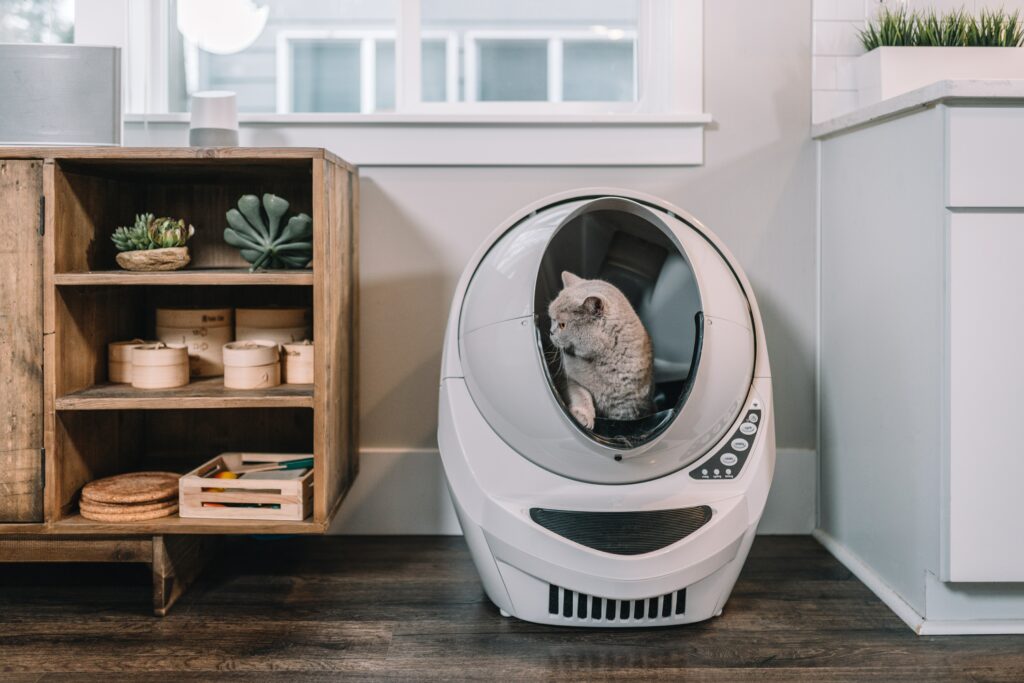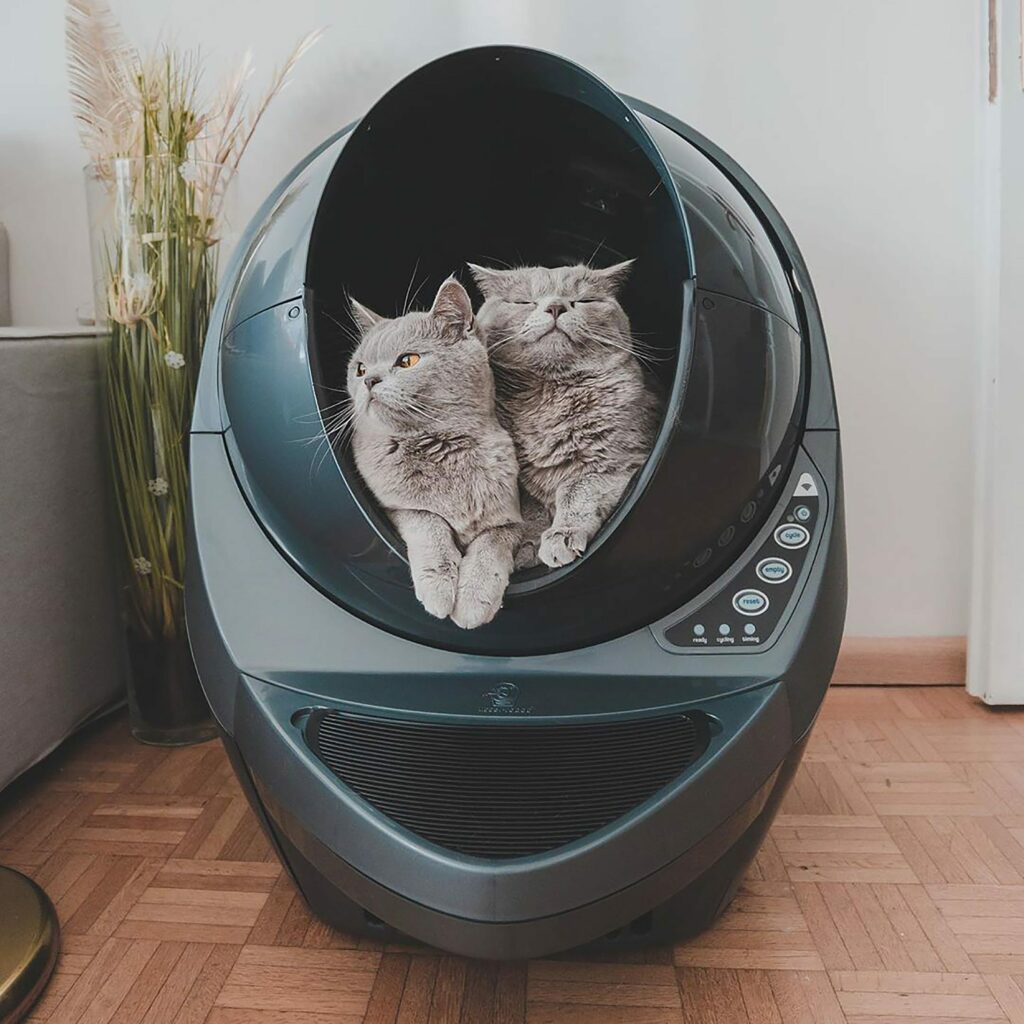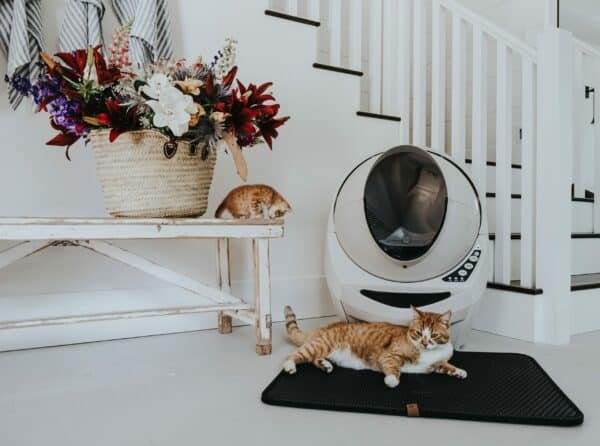We're an affiliate
We hope you love the products we recommend! Just so you know, we may collect a share of sales or other compensation from the links on this page at no additional cost to you. Thank you if you use our links, we really appreciate it!
Are you a cat parent looking for the most effective and low-maintenance way to keep your feline friend’s litter box clean?
You’re not alone. A quick survey will show you that automatic cat litter boxes have been increasing in popularity over the recent past.
This is largely due to their simplicity and convenience, offering pet parents time savings, and odor control, among other benefits.
These litter boxes will help reduce your stress as well as train your cats to love using the litter box consistently, all with minimal effort from you.
Read on to learn more about the advantages of investing in a quality mechanized cat litter box and how it could become an invaluable asset for busy cat owners.
How Self-Cleaning Litter Boxes Work
Automatic cat litter systems work by having a timer or sensors that detect when the litter box has been used or needs to be emptied and refilled.
The self-cleaning mechanism usually consists of some type of sifting system or similar technology that sorts and removes waste clumps, leaving behind clean pellets.
After this auto-cleaning process is complete, the soiled material is then discarded into an enclosed compartment for disposal at a later time.
This means significantly less maintenance for pet owners as they no longer have to manually scoop the spent litter from the box.
Are Self-Cleaning Litter Boxes Worth it?
Robotic cat litter boxes can be a great choice for cat owners who want convenience and cleanliness!
They don’t require any scooping, and some advanced boxes can also self-refill supplies. This can save time and energy from regularly buying or replacing litter.
However, it is important to remember that self-cleaning boxes cost more than traditional boxes.
Additionally, not all cats adjust easily to newer systems, so there may need to be a period of transition for your pet.
Your cats can now experience a more hygienic living space in the comfort of their home, making it worth considering a switch from manual to scoop-free systems.
If you are looking to buy one then make sure you read our guide on the things you need to know before investing in one.
Are Self-Cleaning Litter Boxes More Sanitary?
Automated litter boxes offer cat owners a more hygienic and easier way to clean up than traditional boxes.
These litter boxes use advanced technology to completely sift through the waste and debris with no manual effort required.

This helps reduce odors and keeps your home smelling fresh, while also protecting your family from bacteria exposure and infection due to bacteria found in traditional cat litter box reservoirs.
Although these boxes might be slightly more expensive than traditional litter boxes, their ability to ensure full sanitization gives them a huge advantage over manual cleaning.
6 Benefits of Using a Self-Cleaning Cat Litter Box
The following are some of the advantages of having an automatic cat litter box in your home:
1. No more scooping
Cat owners no longer have to worry about scooping the litter box regularly as these boxes can automatically remove spent litter multiple times a day.
These advanced kitty toilets offer automatic self-sifting, where your pet’s waste is removed from the litter bed so it can stay fresh and ready for the next use.
They are equipped with sensors that identify when the box needs cleaning and rake the clumps away into an enclosed receptacle.
2. Reduces chances of handling waste
With the traditional cat litter boxes, you will be required to handle your cat’s waste every time they use it.
This can be a health hazard when you don’t have the right gear (shovel, gloves, and masks) for the task.
When you make direct contact with a cat’s waste products, there are high chances that you could get exposed to germs and ammonia which can be dangerous.
Severe exposure to cat poop might lead to the transmission of Toxoplasmosis which is caused by the parasite Toxoplasma gondii.
A scoop-free litter box takes away the hassle of handling the waste by discarding the spent litter in a receptacle that is safer to dispose of.
This is also good for houses with small children because they will not be exposed to the cat’s waste that is always left open in the conventional box.
3. Cuts down the bad odor
The sealed disposal system also helps to lock in odors and to keep the dogs away. Additionally, automated cat litter boxes come with air filtration systems that help absorb bad smells.
And, in many cases, reduce tracking of litter particles around the house. This can be helpful if you have allergies.
4. It helps to save on litter
A litter robot will only scoop the soiled litter and leave behind the unspent one with very minimal wastage.
This is usually not the case with traditional boxes where pet parents may end up scooping spent litter with a huge chunk of unused ones. Especially when you have multiple cats who use the litter box in quick succession.
With a self-cleaning system, you can now spend less than half of what you used to spend before, which will cut down your quarterly litter budget.
5. It saves time
Scooping soiled litter can be a huge task when you consider the amount of time you spend doing so every day.
You can now save much time with an automatic litter box and only focus on emptying the receptacle and performing other minimal maintenance.
6. Additional features
Some advanced litter boxes come with a compatible smartphone app that offers quick intuitive control over many features like switching the cleaning cycle on and off or monitoring the current level of litter usage.
Do Cats Like Automatic Litter Boxes?
Most adventurous cats will seem totally at ease with the newest technology. They will happily use their automatic litter boxes and enjoy every moment of their bathroom break.
Timid cats may however reject them immediately, refusing to use them and sometimes even avoiding the area completely.
The beeps, buzzing, and mechanical raking sounds can be quite a shock to them during the first few days.

Make sure to always keep your litter boxes clean because cats will always tend to avoid messed-up areas. They have an instinct of hiding their feces and urine which gives them a sense of security and comfort.
And there’s no way to ensure that you always have a clean litter box other than going for the automatic ones.
Remember to keep your cat in mind when choosing the accessories that are best for them. With proper introduction and patience, you can transition your cat from using traditional boxes to newer ones.
FAQs About Self-Cleaning Cat Litter Boxes
1. Does A Self-Cleaning Cat Litter Box Smell?
One question many cat owners have is whether these scoop-free models cause more of a bad odor than what they were used to before.
Fortunately, the answer is NO. If properly maintained, cat owners should not expect any more odor from cat litter boxes with automated cleaning technology.
These boxes use automated mechanisms that continuously monitor cat usage and clean up after each occurrence. This not only eliminates the smells but keeps your cat’s hygiene area pristine as well.
Some automatic cat litter boxes have features that help reduce unpleasant odors, such as venting systems to allow for efficient airflow and sealable “trash” compartments which help contain bad smells in an enclosed area.
While other factors such as the type of cat litter or sprays used may affect the odor emitted from the cat box, a scoop-free system should not cause any more of a smell than a traditional one.
2. How Do You Introduce a Self-Cleaning Litter Box?
A good way to introduce your kitty to a litter robot is by slowly transitioning them from an open regular litter box.
Once your cat seems comfortable in their traditional boxes, you can then start introducing them to the new model.
Place your litter robot in the same bathroom area where your cat is used to. Shifting the restroom area might make your cat take a longer time in relating to the new place with waste-relieving.
Make sure the area around your litter box is silent, comfortable, and stress-free as cats generally build their trust around a calm environment.
Once you get this done, you can now start by using the new box with one side open so that it remains familiar to the cat.
During this initial phase, turn off the cleaning cycle and allow your cat to explore the box at their own pace.
Once your cat is comfortable using the new box, you can now slowly turn on the cleaning cycle with just short cycles at first until they become accustomed to the noise and motion of the machine.
Proceed by increasing the duration each time, until they become accustomed to the raking noise of the unit.
You can also place treats or toys around and in the box so they associate it with a positive experience.
3. How Long Can You Leave a Self-Cleaning Litter Box?
The amount of time you can leave the litter box unattended depends on the brand’s specifications and what we may call ‘general wear and tear’.
We recommend that you read your product’s user manual to find out what the manufacturer has to say concerning keeping the unit unattended.
Most automatic litter boxes can be left for extended periods without being emptied or cleaned, but typically this should not exceed two weeks.
With proper and regular care during this period, the litter box should continue functioning smoothly without major hitches.
Be sure to devote some time daily to check on your box in case it requires resetting or needs any other repairs, considering that certain brands may require monitoring and mechanical servicing more often.
To Conclude – Are Self Cleaning Litter Boxes Worth It?
Totally! With features that help to reduce bad odors and scoop-free cleaning, there are many benefits of self-cleaning cat litter boxes that you can leverage.
Just remember to introduce your cat slowly and to follow the manufacturer’s specifications when it comes to servicing and maintenance.
Laura is the founder of Furs'n'Paws. She is a also a pet writer and expert with more than 20 years of experience of working with dogs and cats. She developed a very strong love for animals at a young age. Her passion led her to establish a thriving pet sitting and dog walking business in Dubai. As an expert in pet training, behavior, and nutrition, Laura is committed to helping pet owners and pet lovers by offering high-quality information on a wide range of topics.



No responses yet